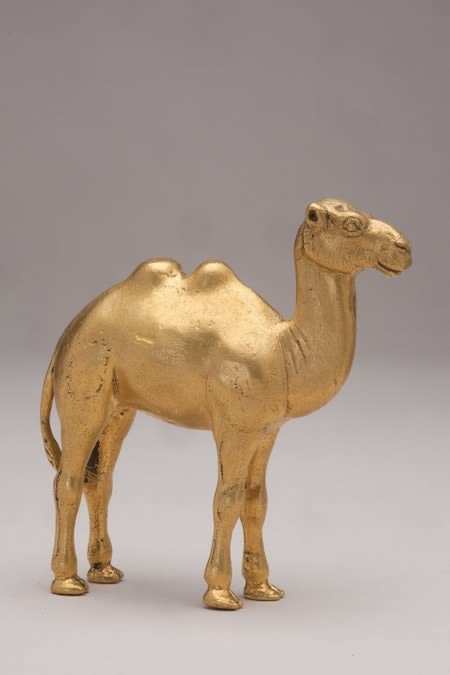Bactrian Gold Camel, 300 BCE - 100 BCE
The Bactrian gold camel, crafted between 300 BCE and 100 BCE, comes from the ancient region of Bactria, located in modern-day Afghanistan, Uzbekistan, and Tajikistan. This area was a hub...
The Bactrian gold camel, crafted between 300 BCE and 100 BCE, comes from the ancient region of Bactria, located in modern-day Afghanistan, Uzbekistan, and Tajikistan. This area was a hub for cultural exchange, positioned along key routes of the Silk Road. Bactria, during this time, was under the influence of Greek culture following the conquests of Alexander the Great. The camel represented a crucial element in the trade network that spanned vast distances. The use of gold suggests this piece was likely a luxury item, possibly created for someone of high status or a successful merchant who relied on trade routes where camels were vital for transporting goods.
The creation of this figure was more than ornamental; objects like this often served ceremonial or symbolic purposes. They could be used in religious practices, as tomb offerings to honor the dead, or as tributes to deities, invoking protection or blessings. The camel itself, central to the survival and prosperity of ancient trade caravans, may have symbolized wealth, endurance, and success in trade. By depicting this animal in gold, the artist not only paid homage to the animal’s significance in commerce but also to its value in connecting different cultures and regions.
This small but striking figurine captures the essence of the Bactrian camel with its distinctive two humps, native to the harsh environments of Central Asia. The sculpture balances careful detail with a certain stylization, embodying both realism and symbolic meaning. Its static pose conveys strength and dignity. The use of gold not only emphasizes the piece’s luxurious nature but also its importance as an object of status or religious significance. Despite its size, the craftsmanship is precise, with smooth surfaces and balanced proportions, creating a lasting tribute to the camel’s role in ancient trade and the artistry of the Bactrian civilization.
The creation of this figure was more than ornamental; objects like this often served ceremonial or symbolic purposes. They could be used in religious practices, as tomb offerings to honor the dead, or as tributes to deities, invoking protection or blessings. The camel itself, central to the survival and prosperity of ancient trade caravans, may have symbolized wealth, endurance, and success in trade. By depicting this animal in gold, the artist not only paid homage to the animal’s significance in commerce but also to its value in connecting different cultures and regions.
This small but striking figurine captures the essence of the Bactrian camel with its distinctive two humps, native to the harsh environments of Central Asia. The sculpture balances careful detail with a certain stylization, embodying both realism and symbolic meaning. Its static pose conveys strength and dignity. The use of gold not only emphasizes the piece’s luxurious nature but also its importance as an object of status or religious significance. Despite its size, the craftsmanship is precise, with smooth surfaces and balanced proportions, creating a lasting tribute to the camel’s role in ancient trade and the artistry of the Bactrian civilization.
1
of
74
